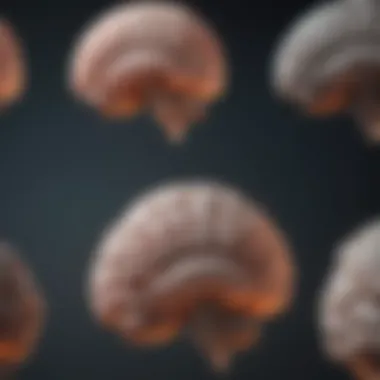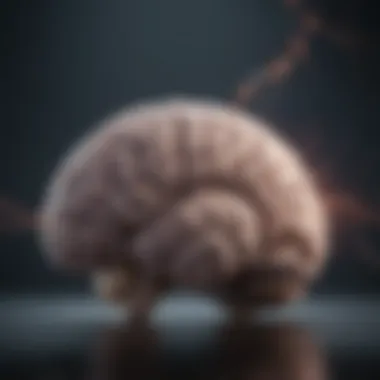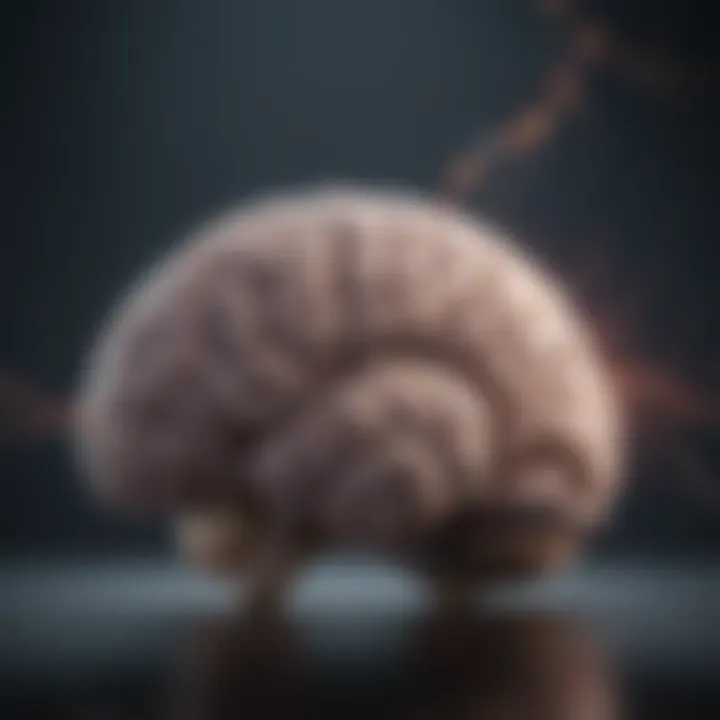Understanding Brain Waves in Human Cognition


Intro
The study of brain waves stands as a critical aspect of electrophysiology. Understanding these electrical impulses provides insight into the inner workings of the human brain. This knowledge is essential for various fields including psychology, neuroscience, and mental health. In recent years, advancements in technology have allowed for enhanced measurement techniques and deeper exploration of this complex subject.
Brain waves reflect the brain's activity and can reveal patterns that correlate with different cognitive states. They are categorized into five main types: delta, theta, alpha, beta, and gamma waves. Each type has distinct characteristics linked to specific mental processes. The significance of analyzing these waves extends beyond mere academic interest; it offers practical applications in diagnosing and treating neurological and psychological conditions.
This article aims to dissect the concept of brain waves thoroughly. By examining the methodologies used and current trends in neuroscience, we can appreciate the relevance and implications of brain wave research in modern science.
Research Overview
Methodological Approaches
Researching brain waves involves various methodologies. The most common is Electroencephalography (EEG), a technique that measures electrical activity in the brain via electrodes placed on the scalp. This non-invasive method provides real-time data about brain activity, making it invaluable for both research and clinical settings.
In addition to EEG, other advanced techniques like functional Magnetic Resonance Imaging (fMRI) and Magnetoencephalography (MEG) contribute to a broader understanding of brain function. fMRI detects changes in blood flow, while MEG measures magnetic fields produced by neural activity, allowing researchers to map brain function with precision.
Significance and Implications
Understanding brain waves is more than an academic exercise; it has far-reaching implications. For instance, in psychology, assessing brain wave patterns can improve understanding of mental disorders. Research shows that atypical brain wave activity may indicate conditions such as ADHD or epilepsy.
Clinical applications extend to treatments such as neurofeedback, where individuals learn to modify their brain waves to alleviate symptoms of anxiety or depression. This underscores the potential of brain wave research to influence therapeutic strategies significantly.
Current Trends in Science
Innovative Techniques and Tools
The field of brain wave research is rapidly evolving. Recently, portable EEG devices have emerged, enabling studies in more diverse environments beyond traditional labs. This flexibility presents opportunities for real-time applications, such as in educational settings or during meditation practices.
Moreover, machine learning algorithms are increasingly applied to analyze brain wave data. These approaches enhance the ability to detect patterns and draw connections that were previously difficult to identify, paving the way for personalized medicine.
Interdisciplinary Connections
The intersection of neuroscience with fields like artificial intelligence and psychology has prompted significant advancements. Collaborative efforts between disciplines enable a more holistic understanding of brain function. For example, researchers are investigating how brain-computer interfaces can aid individuals with disabilities, demonstrating that knowledge of brain waves is not only relevant to traditional fields of study but also extends into practical applications affecting everyday life.
"The integration of neuroscience and technology brings forth an era of unprecedented possibilities in understanding and influencing cognitive functions."
This exploration of brain waves embodies a convergence of science and practical application. As technology continues to evolve, the implications for mental health and cognitive enhancement demonstrate that the study of brain waves is not static but a rapidly advancing frontier.
Preamble to Brain Waves
Understanding brain waves is crucial for comprehending the dynamics of human cognition and behavior. Brain waves represent the electrical impulses generated by neural activity, influencing a wide array of mental processes. From states of deep sleep to high alertness, these waves are a window into how our brains function.
Research in this field reveals patterns that correlate with various psychological states and cognitive functions. Engaging with brain wave analysis can enhance our insight into not only individual behaviors but also collective mental health trends. The exploration of brain waves bridges neuroscience, psychology, and clinical practices, making it a multidimensional topic worth investigating.
Historical Context
The concept of brain waves has been around for over a century. In the early 20th century, Hans Berger conducted experiments that led to the discovery of the electroencephalogram (EEG). This marked a significant moment in neuroscience, allowing for the measurement of electrical activity in the brain.
Since then, the study of brain waves evolved. Psychologists and neurobiologists explored how different frequencies relate to mental states. Each type of wave corresponds to a specific function, and researchers began to correlate these patterns with behaviors, sleep phases, and even mental disorders. This historical backdrop sets the stage for current and future studies in electrophysiology.
Definition and Importance
Brain waves can be defined as oscillating electrical potentials in the brain, measured in hertz (Hz). They vary in frequency and have significant implications for cognitive and emotional states.
Their importance lies in their capacity to inform us about brain health and function. Understanding different types of brain waves allows scientists and clinicians to gain insights into disorders such as epilepsy, anxiety, and depression. Moreover, this knowledge extends to therapeutic practices, making brain waves a central component in fields ranging from psychology to education.
In summary, brain waves are not merely electrical signals; they are a fundamental aspect of understanding the human condition. By deciphering these waves, we can better navigate the complexities of the mind, leading to improved interventions and a deeper appreciation of human cognitive diversity.
Types of Brain Waves


Understanding the various types of brain waves is essential to comprehend how the human brain functions. Brain waves are categorized based on their frequency, measured in hertz (Hz). Each type, from Delta to Gamma, plays a distinct role in our cognition and behavior. Recognizing the types allows us to explore their implications in mental health, cognitive performance, and even spiritual practices.
Delta Waves
Characteristics of Delta Waves
Delta waves are the slowest brain waves. They typically oscillate between 0.5 and 4 Hz. A key characteristic of delta waves is their dominance during sleep, particularly in profound, restorative sleep stages. These waves are crucial for the body's regeneration and healing processes. They support various physiological functions, making them an important focus in sleep studies. Understanding how delta waves operate offers insight into the impact of sleep on overall health. The disadvantage of delta waves may be their association with unconsciousness, limiting active cognitive processes.
Functions and Relevance in Sleep
Delta waves are integral during deep sleep, providing critical restorative functions. Research indicates that they facilitate healing, growth, and maintenance of cells. This highlights their role not just in rest but in rejuvenation. Effectively, delta waves contribute to memory consolidation and the regulation of hormones. While their paramount significance in sleep is widely acknowledged, excessive delta wave activity during waking hours can indicate issues such as certain brain injuries or disorders.
Theta Waves
Role in Creativity and Intuition
Theta waves range from 4 to 8 Hz, occurring predominantly during relaxed states. One prime aspect of theta waves is their association with creativity and intuition. These waves promote mental imagery and the generation of new ideas. Artists and writers often report heightened creativity when their brain oscillates in the theta range. This makes theta waves a beneficial subject in contexts involving creative processes. However, maintaining focus can be challenging when theta waves dominate, potentially hindering goal-directed tasks.
Theta Waves in Meditation
Theta waves are commonly observed in meditative states. They appear as individuals enter deeper levels of consciousness. This unique feature allows for heightened self-awareness and emotional regulation. Meditation practices that invoke theta waves aim to enhance mindfulness and relaxation. While beneficial for mental clarity, individuals may encounter difficulty transitioning back to active states post-meditation, as theta's calming nature can lessen immediate alertness.
Alpha Waves
Mechanisms Involved During Relaxation
Alpha waves oscillate between 8 and 12 Hz and are prominent during relaxed and calm periods. A key characteristic of alpha waves is their facilitation of relaxation while maintaining alertness. They support a state of calm focus, which can positively influence cognitive tasks that require a balanced mindset. These waves contribute to a smooth transition from wakefulness to sleep. However, a challenge arises if one becomes overly reliant on relaxation, leading to decreased productivity.
Impact on Learning and Memory
Alpha waves play a vital role in the learning process. During periods of relaxation, alpha waves aid in the consolidation of memories and information processing. Research has shown that environments conducive to alpha wave production can enhance educational outcomes. While alpha waves facilitate learning, individuals may find their creative thought processes limited when too much alpha is present, pointing to a balance needed between different wave types.
Beta Waves
Association with Alertness and Cognition
Beta waves dominate our waking state, fluctuating between 12 and 30 Hz. A primary characteristic of beta waves includes their association with active thinking and mental engagement. They underpin cognitive functions such as problem-solving and decision-making. In contexts requiring focus and analytical thought, beta waves are essential. However, excessive beta waves can lead to stress and anxiety, which presents a consideration for maintaining a healthy balance.
Implications for Anxiety and Stress
The elevation of beta waves has been linked to increased stress and anxiety levels. Research suggests that individuals experiencing high beta wave activity may also report heightened feelings of tension and restlessness. This duality highlights the need for effective strategies to manage beta waves, such as mindfulness practices, to mitigate associated negative impacts. Understanding beta wave dynamics provides insight into how to enhance cognitive abilities while managing mental health.
Gamma Waves
Relation to Higher Cognitive Function
Gamma waves operate at frequencies higher than 30 Hz. They are notable for their role in higher cognitive functions, including perception and conscious thought. A defining characteristic of gamma waves is their involvement in complex information processing and cognitive functioning. This makes them vital for tasks requiring intense focus and mental agility. One notable advantage is their apparent correlation with enhanced memory recall. However, excessive gamma activity can result in cognitive overload, leading to confusion or mental fatigue.
Research on Consciousness and Perception
Research surrounding gamma waves has unveiled their relation to consciousness and perception. They may play a crucial role in binding sensory information and creating cohesive experiences of reality. This unique feature is vital for understanding how humans interpret the world around them. However, the high-intensity nature of gamma waves necessitates a balance, as too much stimulation can overwhelm cognitive processes, providing a compelling area for continued exploration and understanding.
Understanding the intricate dynamics of brain waves fosters not only awareness of brain health but also highlights the potential for enhancing cognitive function through targeted practices.
Measurement Techniques
Measurement techniques are integral to understanding brain waves. They provide researchers and clinicians with the tools necessary to capture and analyze brain activity. Comprehending these techniques allows for a better grasp of how brain waves operate and their implications for health and cognitive function. Here, we delve into some prominent methods used in the field.
Electroencephalography (EEG)
Principles of EEG


Electroencephalography, commonly known as EEG, measures electrical activity in the brain through electrodes placed on the scalp. These electrodes detect voltage fluctuations resulting from ionic current flows within neurons. One characteristic that makes EEG a favored choice in electrophysiology is its temporal resolution. EEG can capture rapid changes in brain activity, offering insights into immediate cognitive processes.
A unique feature of EEG is its non-invasive nature. It provides a dynamic view of brain activity without the need for surgical intervention. However, while beneficial, EEG does have limitations in spatial resolution. It can localize brain activity, but not with the precision of other imaging techniques.
Clinical and Research Applications
EEG has significant clinical applications, particularly in diagnosing conditions like epilepsy, sleep disorders, and brain injuries. The ability to monitor real-time brain activity makes it an essential tool in both clinics and research laboratories. Its widespread use stems from its cost-effectiveness and accessibility for continuous monitoring.
Moreover, EEG is advantageous in research settings, helping to establish correlations between brain activity and behavioral responses. Despite these strengths, researchers must consider the artifacts that may arise from muscle activity or external noise, as they can obscure results.
Magnetoencephalography (MEG)
How MEG Works
Magnetoencephalography is another advanced imaging technique used to measure the magnetic fields produced by neural activity. By utilizing highly sensitive magnetometers, MEG achieves a spatial resolution superior to that of EEG. The key characteristic of MEG is its ability to localize brain function in three-dimensional space with a high degree of precision.
The unique feature of MEG is that it captures both the timing and location of brain activity. As a result, it is exceedingly beneficial in pre-surgical planning for brain surgeries. However, MEG can be more expensive and less accessible compared to EEG.
Advantages and Limitations of MEG
One of the significant advantages of MEG is its high spatial and temporal resolution, enabling the mapping of brain functions in real time. This feature allows researchers to study complex cognitive tasks and understand how different regions of the brain interact. However, MEG does have limitations. The need for a specialized and often costly environment, such as magnetically shielded rooms, can limit its availability. Additionally, MEG is sensitive to background noise, which may affect readings.
Functional MRI (fMRI)
fMRI Overview
Functional MRI measures brain activity through changes in blood flow. As neurons become more active, they require more oxygen, which is reflected in blood flow changes. fMRI provides both structural and functional imaging, making it a popular technique in neuroscientific research.
One characteristic that makes fMRI a beneficial choice is its high spatial resolution, which allows researchers to identify specific brain regions involved in various activities. The ability to observe brain function and structure concurrently is a unique feature of fMRI, although it requires exposure to strong magnetic fields.
Interpreting Functional Activity in the Brain
Interpreting the data obtained from fMRI can offer insights into how different brain areas communicate during tasks. This ability to analyze functional connectivity is essential in understanding cognitive processes. A notable characteristic that enhances its use is the application of statistical modeling to discern the significance of observed activities. However, the complexity involved in fMRI data analysis can present challenges, requiring careful consideration of methodological choices to avoid misleading conclusions.
Utilizing varied measurement techniques enriches our understanding of brain activity. Each method offers unique advantages and drawbacks that researchers weigh in their studies.
Brain Waves and Mental Health
Brain waves play a crucial role in mental health, as they are directly connected to how we feel and think. An understanding of brain wave patterns can significantly contribute to addressing mental health issues. This section explores how specific brain waves relate to mental health, focusing on neurofeedback therapy and the impact of brain wave dynamics on mood disorders.
Neurofeedback Therapy
Overview of Neurofeedback
Neurofeedback is a technique that uses real-time displays of brain activity to teach self-regulation of brain function. It is growing in importance, particularly in the area of mental health. One key characteristic of neurofeedback is its non-invasive nature; there is no surgery or chemical involvement. Instead, it utilizes EEG technology to monitor brain wave patterns, providing feedback through visual or auditory signals. This unique feature makes it appealing for those seeking alternative treatments for mental health conditions.
Neurofeedback has gained popularity due to its potential application in various disorders, such as Attention Deficit Hyperactivity Disorder (ADHD) and anxiety. The advantages of this therapy include its ability to empower individuals to gain control over their mental state, fostering resilience and improved emotional regulation. However, disadvantages may include the variability in individual responses and the need for dedicated training to maximize effectiveness.
Efficacy in Treating Disorders
The efficacy of neurofeedback in treating mental health disorders cannot be overlooked. Research indicates that individuals undergoing neurofeedback often show significant improvements in symptoms related to anxiety, depression, and attention deficit disorders. This characteristic illustrates its growing acceptance as a viable treatment option within the mental health community.
One unique feature of neurofeedback is its basis on operant conditioning. Participants learn to modify their brain wave activities based on feedback, creating a personalized approach to mental wellbeing. Though it holds advantages, such as non-reliance on medication, there are still concerns regarding its consistency across different studies. Ongoing research will help clarify its effectiveness.
Impact on Mood Disorders
Correlation of Brain Wave Patterns with Depression
Understanding the correlation of brain wave patterns with depression sheds light on the underlying mechanisms of this mood disorder. Research has established that certain patterns, specifically the dominance of theta and delta brain waves, may indicate depressive states. This aspect is critical because it helps establish biomarkers for diagnosing and monitoring depression.


The key characteristic of this correlation is its ability to guide treatment approaches. By analyzing brain wave patterns, clinicians may tailor interventions more effectively. Unique advantages include the opportunity for targeted therapies that address specific dysfunctions in brain wave activity. However, one disadvantage is the need for comprehensive brain testing, which may not always be feasible in clinical settings.
Anxiety Disorders and Brain Wave Dynamics
The relationship between anxiety disorders and brain wave dynamics further emphasizes the significance of understanding brain waves in mental health. In individuals with anxiety, there is often an increase in beta waves, which can signify heightened alertness. This characteristic connects directly to feelings of unease and dread prevalent in anxiety disorders.
One beneficial aspect of examining brain wave dynamics in anxiety is the potential for developing targeted therapies that focus on reducing excessive beta wave activity. This specificity in treatment can lead to more effective management strategies. However, a unique challenge exists in the variability of brain wave patterns among individuals, which complicates the establishment of standardized treatment protocols.
"Understanding brain wave patterns not only informs mental health practices but also paves the way for innovative therapeutic approaches."
Applications of Brain Wave Research
The study of brain waves provides insight with wide-ranging implications, especially in fields like psychology, education, and medicine. Brain wave research has the potential to enhance our understanding of cognitive functions and mental health conditions. This area of study not only helps in diagnosing disorders but also paves the way for innovative treatments. Understanding these applications is vital for students, researchers, educators, and professionals interested in the interface of science and human behavior.
Cognitive Enhancement
Methods to Optimize Brain Function
Cognitive enhancement techniques are aimed at improving mental processes such as memory, attention, and problem-solving. Techniques like neurofeedback and transcranial magnetic stimulation utilize brain wave modulation to optimize cognitive performance. These methods capitalize on the brain's neuroplasticity—its ability to reorganize and adapt. Neurofeedback, for instance, provides real-time feedback on brain activity, enabling individuals to consciously influence their own brain states.
- Key Characteristic: The main aspect of cognitive enhancement methods is their adaptability. They cater to individual needs, making them a personalized approach toward improving cognitive function.
- Unique Feature: One of the primary advantages is the non-invasive nature of these methods, which is appealing for many. However, there are still debates about their efficacy and safety in long-term use.
Controversies Surrounding Cognitive Enhancement
While cognitive enhancement is gaining popularity, it is not without controversies. Ethical questions arise concerning access, equity, and potential misuse of enhancement techniques. Some worry that these methods could create a divide between those who can afford enhancement and those who cannot.
- Key Characteristic: A notable aspect of these controversies is their ethical implication. Discussions about the morality of enhancing cognition touch upon fundamental issues of fairness and societal pressure.
- Unique Feature: Critics point out that while enhancements may offer temporary benefits, they might also lead to dependency or diminishing returns over time. This raises questions about the long-term impacts on mental health and overall brain function.
Advances in Neuroscience
Innovative Studies and Discoveries
New studies and discoveries in neuroscience are constantly reshaping what we know about brain waves and their functions. For instance, recent advances in imaging techniques have further clarified the relationship between specific brain wave patterns and cognitive tasks. Research into the neural correlates of consciousness has opened new avenues for understanding phenomena like creativity and intuition.
- Key Characteristic: The innovative nature of these studies provides detailed insights into the brain's intricate mechanisms. Their significance lies in the potential applications for both enhancing cognitive performance and treating disorders.
- Unique Feature: Innovation is often paired with collaboration across disciplines. This cross-collaboration enriches the research landscape but can also complicate interpretations of findings.
Future Directions in Brain Wave Research
The future of brain wave research looks promising with advancements in technology and methodology. Innovations in artificial intelligence, for example, can enhance our ability to analyze data from brain waves, providing deeper insights into mental activities. Researchers are also looking into optimizing existing methodologies, making them more accessible and practical for clinical settings.
- Key Characteristic: Focusing on improving methodologies can expand our understanding significantly. Scientific advancements will likely lead to better diagnostic tools and treatment options for cognitive-related disorders.
- Unique Feature: While the future is bright, challenges remain in ethical considerations, data security, and the need for rigorous validation of findings. Addressing these considerations is critical for responsible research and application in the years to come.
"The exploration of brain wave applications opens new frontiers in understanding human cognition and behavior. Its relevance spans across disciplines, underscoring the interconnected nature of neuroscience and practical human applications."
Through this examination, the importance of brain wave research becomes clear. The ongoing inquiry promises not only to illuminate our understanding of mental phenomena but also to better the lives of individuals dealing with cognitive challenges.
Ending
The conclusion section serves as a synthesis of the findings presented throughout the article. It emphasizes the relevance of understanding brain waves in contemporary science, specifically in context of cognition, behavior, and health. The importance of this topic cannot be understated; not only is it fundamental to neurophysiology, but it also opens avenues for applications in clinical psychology, mental health treatments, and cognitive enhancement techniques.
Summary of Key Findings
Throughout this article, several vital points emerge regarding brain waves:
- Types of Brain Waves: Each type, including Delta, Theta, Alpha, Beta, and Gamma waves, demonstrates distinct characteristics and functions. Their interactions and balance are crucial for optimal brain function.
- Measurement Techniques: Methods such as Electroencephalography (EEG), Magnetoencephalography (MEG), and functional MRI (fMRI) allow researchers to study brain activity with precision, each offering unique insights.
- Mental Health Correlation: Brain wave patterns influence mental health, with variations in their activity linked to conditions such as anxiety and depression.
- Applications in Neuroscience: Cognitive enhancement strategies and ongoing research contribute to an evolving understanding of how to optimize brain function.
Given the complexity of the neural mechanisms, ongoing research is fundamental to fully grasp the multitude of factors involved in brain wave dynamics.
Implications for Future Research
Future research on brain waves holds promising potential in both theoretical and applied domains. Exploring additional dimensions such as:
- Longitudinal Studies: To establish causal relationships between brain wave activity over time and mental health outcomes.
- Personalized Neurofeedback: Enhancing therapeutic approaches based on individual brain activity patterns.
- Advanced Imaging Technologies: Utilizing breakthroughs in imaging techniques to provide deeper insights into real-time brain processes.
As the field advances, the integration of interdisciplinary approaches will be crucial. Collaborative efforts among neuroscientists, psychologists, and engineers can drive innovative strategies, potentially leading to breakthroughs in mental health therapies and cognitive enhancement methodologies.
"Understanding brain waves is not just an academic pursuit; it is a gateway to enhancing human potential and addressing medical needs in a more informed manner."



